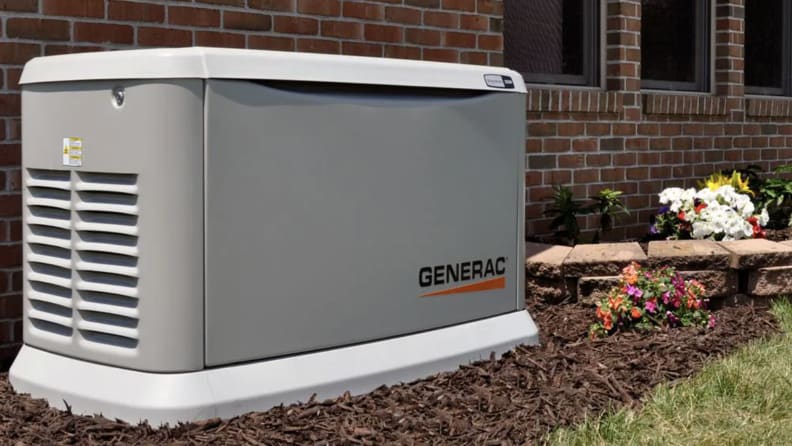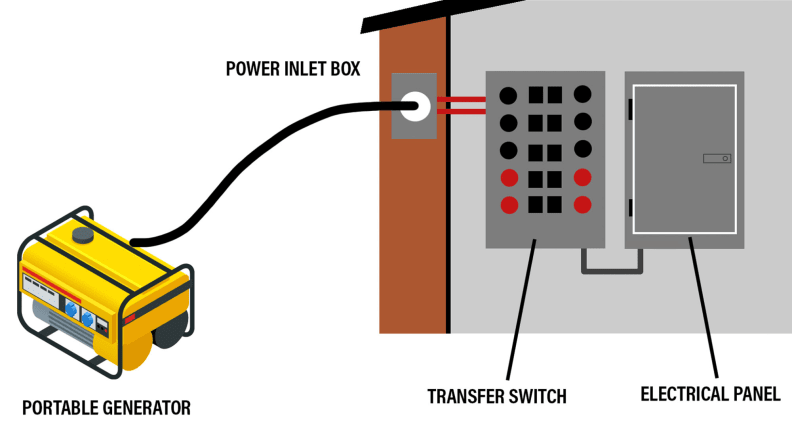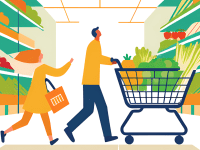Everything you need to know about buying a backup generator
Standby vs. portable generators: Which is best for your home?
Products are chosen independently by our editors. Purchases made through our links may earn us a commission.
Nothing makes us more aware of our dependence on electricity than a sudden blackout. You’re sitting alone in a dark room, mind abuzz with questions about how to handle your predicament. When was the last time you saved that project you were just working on? Do you even have candles, and where are they? Should you try to check the internet for news, or does it make more sense to conserve your phone's remaining battery life for emergencies? How long should you wait before eating all your ice cream?
A combination of increasingly violent weather and aging infrastructure has been steadily amping up the severity and frequency of power outages for decades now—and there's no sign that trend is changing. If you’re looking to keep your home running through a blackout, a generator is your best bet. As with most cases, however, it’s important to choose the right tool for the job. And, in this case, the best solution for your budget.
Choosing the right type of generator
The first question to ask is what type of generator best suits your needs. There are four types of backup generators, each with their own unique list of pros and cons. For example, a standby generator keeps your whole home powered, but it’s an expensive proposition. There are other, less expensive options that can help take the edge off an outage.
Standby generators: Expensive but strong backup for the whole house

Standby generators aren't portable, but they're the best and most automatic way to keep your home running during an outage. But they're a significant investment.
Also referred to as stationary or whole-house generators, these units run on either propane or natural gas and can efficiently power your entire home.
If the only reason you’re buying a generator is to provide total coverage during a power outage, a standby generator is your best bet—but it won’t come cheap. In addition to the high cost of the unit itself, you also need to factor in the price of on-site installation. While it’s impossible to determine the total bill up front, a good rule of thumb is to anticipate that installation will run you about twice the price of the generator itself.

Whole house generators are the best—and most expensive—means of staying powered during a blackout.
Portable generators: Affordable and effective

Portable generators can be moved from place to place and can power your entire home, though they're best used as a short-term solution.
Unlike standbys, portable generators are comparatively affordable, but they often require much more work.
These devices usually run on gasoline (although there are models that use liquid propane, natural gas, or diesel fuel) and have the advantage of being mobile. This means that you can take them along to job sites, where they can be effective for powering everything from tools to lights and more.
The advantage of portability does have its downside: These devices are often extremely loud and significantly less energy efficient than a standby generator. You also have to maintain a level of safety, and never run a portable generator in the house.

This portable generator accepts gas and propane.
Inverter generators: Easy electricity on the go

Inverter generators like this one are typically less noisy than other portable generators, but often can't output enough energy to power a whole house.
Looking for a quieter generator that you can take along to a campsite? Inverter generators are the way to go.
This subset of portable generators runs on gas or propane and can be transported from place to place. They are also far more lightweight and quiet than standard portables.
With more sophisticated engines allowing for greater energy efficiency, inverters are ideal for juicing up everything from lights and air conditioners to electronics, smartphones, and more. That being said, inverters are better suited for a long camping trip than they are powering a house full of appliances.

Inverter generators are more lightweight and portable, making them great for camping.
Portable power stations: A quick fix for your smartphone—but not much else

Portable power stations are can keep all your electronics online for quite a while, but aren't powerful enough to keep most large appliances up and running.
If you don’t have the resources necessary for one of the generators we've already mentioned, but at the very least want to make sure you always have the use of your phone during a power outage, a portable power station is a good compromise.
These devices don’t burn fuel at all, and they are more like large, rechargeable batteries that you plug in. They might lack the raw power and longevity you can get from other types of generators, but they’ll keep your laptop and smartphone going during emergencies.

Portable power stations are great for keeping your phone and laptop charged during a blackout
Powering your entire house: Standby vs. portable generators
One of the most common reasons people research generators is because they’re looking to power their whole home in the case of a power outage. If that’s the case, your options basically boil down to a standby or portable generator—an inverter could power your refrigerator, but not much else, and a power station won’t even keep your ice cream from melting (though you will be able to tweet about it).
Portable generators
- Typically cost between $500 and $1,500
- Can be moved and set up at different locations
- Its exhaust presents a carbon monoxide poisoning hazard—needs to be set up outside, away from the house, and therefore might additionally require weatherproof casing
- Requires more manual operation and monitoring
- More frequent fuel refills
- Not well-suited for days-long outages—typically more of a short-term solution
Standby generators
- The unit and installation typically costs between $10,000 and $20,000
- Wired directly into you home’s electrical system, so it can’t be relocated
- Requires less manual operation, often none at all
- Comes in weatherproof, insulated casing that makes it run much more quietly
- Typically uses a propane tank (can operate for weeks without refueling) or natural gas (doesn’t require refueling at all)
Manual or automatic? How your transfer switch affects your generator experience
Regardless of which type of generator you choose, it’ll need to be routed through a transfer switch first. Transfer switches are a relatively deep topic in and of themselves, but, in general, you’ll need to choose between a manual and an automatic system.

A portable generator plugs into your house via an inlet box, while a standby generator is wired directly into the system. Either way, they'll connect to a transfer switch first.
While portable generators are typically paired with a manual transfer switch, and a standby generator installation often comes bundled with an automatic transfer switch, the generator type is independent from the type of transfer switch—and the type of transfer switch greatly affects how you interact with your generator.
A manual transfer switch is significantly cheaper to purchase and install, but it requires manual activation during a power outage. You’ll also need to manually switch back to utility power once the outage is over, which means either monitoring the utility line itself or keeping an eye on your provider’s website for updates. As an additional bit of upkeep, you’ll need to run your home off the generator once every month or so to keep everything in working order.
Does this all sound like too much work? Then an automatic switch is for you. They’re more expensive to install and maintain (continuously checking the incoming line for outages does use a small, consistent amount of electricity), but it typically automates all of the steps outlined above.

A fully automated system will recognize fluctuations in power and swap over to your generator. Once the fluctuations cease, it will switch back to the utility line and power down the generator.
The system detects any outages, swaps between the utility line and the generator when required, and then swaps back again and powers down the generator once the incoming electricity is stable.
Additionally, the generator’s monthly maintenance can be scheduled to occur on a date and time of your choosing—even activated manually via a smartphone app. Of course, if you’re pairing an automatic transfer switch with a portable generator, some of the process can’t be automated: You’ll still have to manually set up the generator outside and plug it into the inlet box, then turn it off and put it back in storage once the power is back on.


